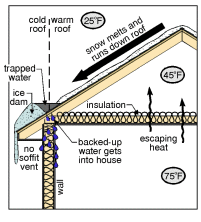What is an Ice Dam? Prevention and Advice

Snow on your driveway is seldom more than a pain in the back. However, snow on your roof can lead to leakage, even if your roof is new. The culprit is ice damming, the insidious snow-melting phenomenon that many of us are well-acquainted with. Since ice damming is climate driven, warm weather can make many believe that come summer, their problem is solved — think again. Without a permanent solution ice dams will continue to form on your roof when it gets cold enough. We encourage homeowners to familiarize themselves with ice damming to help better protect their roofs and their homes.
What is Ice Damming and why is it Problematic?

Heat escapes from the interior of the home into the attic through air leakage in the ceiling or poorly insulated sections of the attic, melting the snow on the roof above. As the snow melts, it runs down the roof until it encounters unmelted snow on the unheated space on the roof. There, it will stop and refreeze. This process will continue until an ice dam is formed. If the dam is large enough, water will back up under the shingles and leak into the eaves, exterior walls, and building interior. While it is periodic, (eventually the weather will warm up, thus stopping the leak), this water intrusion can become costly. If left uncorrected, water damage will occur to at least the ceiling or wall finishes, and at worst, there is a potential for structural rot.
Some roofs are more prone to ice damming than others. Ice dams are most commonly formed on roofs with low slopes or roofs that change from a steep slope down to a low slope. The largest dams tend to form over unheated areas, such as eaves, porches, and attached garages. Ice dams are also common above party walls and below skylights.
Ice damming doesn’t necessarily happen every winter. Ice dams normally form after periods of heavy snowfall when daytime temperatures are at, or slightly above, freezing, and night time temperatures are below freezing.
There are three major preventative measures to consider when approaching the issue of ice damming:
1. Adding attic insulation
The trick is to keep the attic, and therefore the roof surface, cold enough that the snow does not melt.
This will work well depending on the attic in question. However, some attics have so many warm air leaks that it would be impossible to add enough insulation to fix the problem – which is why you should also consider the second approach.
2. Sealing the air leaks
In many cases, with proper sealing tools, a homeowner can take care of this task themselves. However, some situations require a specialist to find and fix the issue. Common air leakage paths include attic access hatches, ceiling light fixtures (especially potlights), and plumbing stacks.
3. Improving attic ventilation
Additional attic venting can help to flush out excess warm air in the attic before it can heat up the roof and melt the snow.
Become an expert on home care by staying informed with tips like these. Start following us on Facebook or Google+.
Copyright 2015/2016 Carson, Dunlop & Associates Ltd. All rights reserved.
No text may be copied from this article without the express written permission of Carson, Dunlop & Associates Ltd.

















